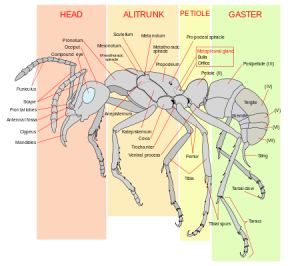The pharaoh ant (Monomorium pharaonis) is a small (2 mm) yellow or light brown, almost transparent ant notorious for being a major indoor nuisance pest, especially in hospitals.[1] The pharaoh ant, whose origins are unknown, has now been introduced to virtually every area of the world, including Europe, the Americas, Australia and Southeast Asia. This species ispolygynous, meaning each colony contains many queens, leading to unique caste interactions and colony dynamics. This also allows the colony to fragment into bud colonies quickly. Colonies do not display aggression toward each other; this is known as unicoloniality. Monomorium pharaonis is also notable for its complex foraging system, involving intricate trail routes maintained with several pheromones. It was the first ant species discovered to use a negative (repellant) pheromone. These chemicals are integral for communication in this species. Pharaoh ants are a tropical species, but they thrive in buildings almost anywhere, even in temperate regions provided central heating is present.
Biology and Nesting Habits
The Pharaoh ant colony consists of queens, males, workers, and immature stages (eggs, larvae, pre-pupae, and pupae). Nesting occurs in inaccessible, warm (80 to 86°F), humid (80%) areas near sources of food and/or water, such as in wall voids. The size of the colony tends to be large but can vary from a few dozen to several thousand or even several hundred thousand individuals. Approximately 38 days are required for development of workers from egg to adult.
Mating takes place in the nest, and no swarms are known to occur. Males and queens usually take 42 days to develop from egg to adult. The males are the same size as the workers (2 mm), are black in color and have straight, not elbowed, antennae. Males are not often found in the colony. The queens are about 4 mm long and are slightly darker than the workers (Smith and Whitman 1992). Queens can produce 400 or more eggs in batches of 10 to 12 (Peacock et al. 1950). Queens can live four to 12 months, while males die within three to five weeks after mating (Smith and Whitman 1992).
Part of the success and persistence of this ant undoubtedly relates to the budding or splitting habits of the colonies. Numerous daughter colonies are produced when a queen and a few workers break off from the mother colony. Even in the absence of a queen, workers can develop a queen from the brood, which is transported from the mother colony. In large colonies there may be as many as several hundred reproductive females (Smith and Whitman 1992).

English: Compared size of a pharaoh ant (Photo credit: Wikipedia)
Management
Control of Pharaoh ants is difficult, due to their nesting in inaccessible areas. Treatment must be thorough and complete at all nesting sites, as well as the foraging area. Thus, treatment must include walls, ceilings, floor voids, and electrical wall outlets. Baits are now the preferred method of control for Pharaoh ants and several baits (insecticides) are labeled for indoor ant control. A Pharaoh ant infestation of a multifamily building requires treatment of the entire building to control the infestation. Ants nesting on the outside may be controlled by also using a perimeter barrier treatment (Smith and Whitman 1992).
Baits cannot be placed in just any location and be expected to work. Pharaoh ant trails and their resources (both food and water) must be located for proper placement of baits and effective control (Klotz et al. 2000). Non-repellent baits (such as boric acid, hydramethylon or sulfonamide) should be used, as repellent baits can worsen the situation by causing the colony to fracture and bud. As a result, ant activity will briefly diminish as the new colonies establish, then become a problem as the foragers resume activity (Smith and Whitman 1992).
In addition, insect growth regulators (IGRs) are marketed for indoor control of Pharaoh ants. The IGR is used as a bait, and ants must be allowed to transport the bait back to their nests. The IGR prevents the production of worker ants and sterilizes the queen. Therefore, it is necessary to allow up to several weeks or months (depending on the size of the colonies or number of colonies) for ants to die naturally with the use of IGR.
Eradication
While you can certainly use your own methods of ant control and natural methods such as diatomaceous earth applications, it would be far more convenient and less worrisome on your part to let Atak Pest Control, Inc. manage them for you. We will use our industry standard Home Pest Control Package to quietly and effectively keep your pharoah ant problem at bay, away from you and your guests and giving you that peace of mind that you have worked so hard to attain.
Sources: http://en.wikipedia.org/wiki/Pharaoh_ant, http://entnemdept.ufl.edu/creatures/urban/ants/pharaoh_ant.htm






